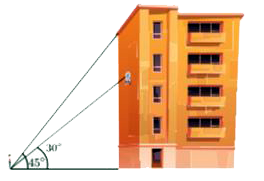Have you ever looked up at a towering skyscraper or even a tall house and wondered, “How tall is that building?” Whether you’re a student working on a school project, an engineer on a site, or just someone who loves urban architecture, knowing how to measure building height is a handy and often necessary skill.
Luckily, you don’t need to be a surveyor with expensive gear to find out. There are several simple and effective ways to measure the height of a building from using your smartphone to applying basic geometry or even just a stick and some sunlight.
One easy method if the ground around the building is flat is to use the shadow it casts. Wait for the sun to create a clear shadow from the top of the building, then measure the length of that shadow on the ground.
How to Measure the Height of a Building height is by using basic trigonometry. Just stand a known distance from the building, measure the angle from the ground to the top, and then use this simple formula: height = distance × tan(angle).
In this comprehensive guide, we’ll explore multiple ways to accurately measure building height, explain the math behind the methods, and help you choose the right approach based on your tools, location, and accuracy needs.
Why Would You Need to Measure Building Height?

Before diving into the how-to, let’s look at a few reasons why people measure building heights:
- Architectural planning and design
- Land surveys and zoning applications
- Construction and engineering inspections
- Educational science or math projects
- Drone flight regulations and safety planning
- Personal curiosity or photography purposes
No matter your reason, choosing the right method is crucial to getting an accurate measurement.
Methods to Measure the Height of a Building
There are a variety of techniques to measure building height, each with its pros and cons. Here’s a breakdown of the most common and practical methods.
1. Using a Measuring Tape (Only for Short Buildings)
Best for:
- Small structures
- Indoor measurements
How it works:
- Use a long tape measure from the base to the top (accessible via ladder, scaffolding, or interior floors).
Pros:
- Simple and direct
- Very accurate (for small heights)
Cons:
- Impractical or dangerous for tall buildings
- Limited by the length of the tape
2. Using a Clinometer or Theodolite and Trigonometry
Best for:
- Professional or semi-professional fieldwork
- Outdoor measurements of medium to tall structures
Tools you’ll need:
- Clinometer or Theodolite (or a smartphone app)
- Measuring tape or rangefinder for base distance
- Calculator or trigonometric table
How it works:
- Stand a known distance from the base of the building (e.g., 30 meters).
- Use the clinometer to measure the angle of elevation to the top.
Use this trigonometric formula:
- Height = Distance × tan(θ)
- Don’t forget to add your eye-level height to the final answer.
Pros:
- High accuracy
- Suitable for tall buildings
- No physical contact with the building needed
Cons:
- Requires basic understanding of trigonometry
- Need clear visibility of the top
3. Using Your Smartphone and an Angle App
Best for:
- Students
- DIY hobbyists
- Informal or educational use
How it works:
- Download an angle measurement app (e.g., Clinometer+, Theodolite, or Smart Measure).
- Measure angle from eye level.
- Measure or estimate the distance from the building.
- Apply the same trigonometric formula:
- Height = Distance × tan(θ)
Pro Tip:
- Combine with a laser rangefinder for more accurate distance measurement.
Pros:
- No need for expensive tools
- Accessible and user-friendly
- Great for educational demonstrations
Cons:
- Less accurate than professional instruments
- Limited by phone camera and sensor calibration
4. Shadow Method (Using Similar Triangles)
Best for:
- Sunny days
- Quick outdoor estimations
How it works:
- Measure the shadow length of the building.
- Measure the shadow and height of a stick or object of known height.
Use proportions:
- Building Height = (Building Shadow × Stick Height) / Stick Shadow
Example:
- Stick height = 1 meter
- Stick shadow = 0.5 meters
- Building shadow = 10 meters
- Height = (10 × 1) / 0.5 = 20 meters
Pros:
- Super simple and no tech needed
- Great for young learners
Cons:
- Only works with clear, sunny skies
- Shadows must be straight and unobstructed
5. Using Google Earth or Satellite Tools
Best for:
- Checking height of well-known buildings
- Virtual assessments
How it works:
- Use 3D mode in Google Earth.
- Click on the base and top of the building.
- Google Earth will give an approximate height.
Pros:
- Convenient and remote
- Good for public or landmark buildings
Cons:
- May not be precise
- Not suitable for unknown or custom structures
Tips for Accurate Measurements
Use the right tools for the size of the building.
- Double-check your base distance errors in distance lead to big errors in height.
- Repeat your measurements to average out mistakes.
- Ensure visibility of the top of the building for any angle-based methods.
- Don’t forget to add eye height when calculating from the ground.
Real-World Examples and Case Studies
📘 School Project:
A group of 8th graders used the shadow method to estimate the height of their school building. With just a meter stick and a stopwatch to time the sun’s movement, they calculated a building height of 12.2 meters only 5% off from the actual!
🏗️ Construction
A civil engineer used a theodolite and trigonometry to measure a new office tower’s height during progress checks. By recording the angle from two distances and averaging the results, they confirmed that the current floor slab aligned with design expectations.

